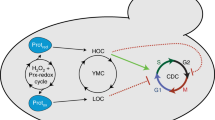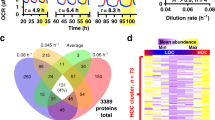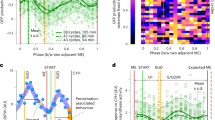Abstract
Metabolic cycles result from the partitioning of oxidative and reductive metabolism into rhythmic phases of gene expression and oscillating post-translational protein modifications. Relatively little is known about how these switches in gene expression are controlled, although recent studies have suggested that transcription itself may play a central role. This review explores the molecular basis of the metabolic and gene-expression oscillations in the yeast Saccharomyces cerevisiae, as well as how they relate to other biological time-keeping mechanisms, such as circadian rhythms.
This is a preview of subscription content, access via your institution
Access options
Subscribe to this journal
Receive 12 print issues and online access
$189.00 per year
only $15.75 per issue
Buy this article
- Purchase on Springer Link
- Instant access to full article PDF
Prices may be subject to local taxes which are calculated during checkout




Similar content being viewed by others
References
Pattanayak, G. & Rust, M.J. The cyanobacterial clock and metabolism. Curr. Opin. Microbiol. 18, 90–95 (2014).
Ray, S. & Reddy, A.B. Cross-talk between circadian clocks, sleep-wake cycles, and metabolic networks: dispelling the darkness. BioEssays 38, 394–405 (2016).
Edgar, R.S. et al. Peroxiredoxins are conserved markers of circadian rhythms. Nature 485, 459–464 (2012).
Tomita, J., Nakajima, M., Kondo, T. & Iwasaki, H. No transcription-translation feedback in circadian rhythm of KaiC phosphorylation. Science 307, 251–254 (2005).
O'Neill, J.S. & Reddy, A.B. Circadian clocks in human red blood cells. Nature 469, 498–503 (2011).
Causton, H.C., Feeney, K.A., Ziegler, C.A. & O'Neill, J.S. Metabolic cycles in yeast share features conserved among circadian rhythms. Curr. Biol. 25, 1056–1062 (2015).
Novák, B. & Tyson, J.J. Design principles of biochemical oscillators. Nat. Rev. Mol. Cell Biol. 9, 981–991 (2008).
Reddy, A.B. & Rey, G. Metabolic and nontranscriptional circadian clocks: eukaryotes. Annu. Rev. Biochem. 83, 165–189 (2014).
Schick, S. et al. Identifying novel transcriptional regulators with circadian expression. Mol. Cell. Biol. 36, 545–558 (2015).
Koike, N. et al. Transcriptional architecture and chromatin landscape of the core circadian clock in mammals. Science 338, 349–354 (2012).
Morf, J. et al. Cold-inducible RNA-binding protein modulates circadian gene expression posttranscriptionally. Science 338, 379–383 (2012).
Rodriguez, J. et al. Nascent-Seq analysis of Drosophila cycling gene expression. Proc. Natl. Acad. Sci. USA 110, E275–E284 (2013).
Hurley, J.M. et al. Analysis of clock-regulated genes in Neurospora reveals widespread posttranscriptional control of metabolic potential. Proc. Natl. Acad. Sci. USA 111, 16995–17002 (2014).
Guo, J., Cheng, P., Yuan, H. & Liu, Y. The exosome regulates circadian gene expression in a posttranscriptional negative feedback loop. Cell 138, 1236–1246 (2009).
Nguyen, T. et al. Transcription mediated insulation and interference direct gene cluster expression switches. eLife 3, e03635 (2014).
Hendriks, G.J., Gaidatzis, D., Aeschimann, F. & Großhans, H. Extensive oscillatory gene expression during C. elegans larval development. Mol. Cell 53, 380–392 (2014).
Robles, M.S., Cox, J. & Mann, M. In-vivo quantitative proteomics reveals a key contribution of post-transcriptional mechanisms to the circadian regulation of liver metabolism. PLoS Genet. 10, e1004047 (2014).
Jang, C., Lahens, N.F., Hogenesch, J.B. & Sehgal, A. Ribosome profiling reveals an important role for translational control in circadian gene expression. Genome Res. 25, 1836–1847 (2015).
Janich, P., Arpat, A.B., Castelo-Szekely, V., Lopes, M. & Gatfield, D. Ribosome profiling reveals the rhythmic liver translatome and circadian clock regulation by upstream open reading frames. Genome Res. 25, 1848–1859 (2015).
Lipton, J.O. et al. The circadian protein BMAL1 regulates translation in response to S6K1-mediated phosphorylation. Cell 161, 1138–1151 (2015).
Murray, D.B., Beckmann, M. & Kitano, H. Regulation of yeast oscillatory dynamics. Proc. Natl. Acad. Sci. USA 104, 2241–2246 (2007).
Tu, B.P. et al. Cyclic changes in metabolic state during the life of a yeast cell. Proc. Natl. Acad. Sci. USA 104, 16886–16891 (2007).
Mohler, R.E. et al. Identification and evaluation of cycling yeast metabolites in two-dimensional comprehensive gas chromatography-time-of-flight-mass spectrometry data. J. Chromatogr. A 1186, 401–411 (2008).
Dallmann, R., Viola, A.U., Tarokh, L., Cajochen, C. & Brown, S.A. The human circadian metabolome. Proc. Natl. Acad. Sci. USA 109, 2625–2629 (2012).
Eckel-Mahan, K.L. et al. Coordination of the transcriptome and metabolome by the circadian clock. Proc. Natl. Acad. Sci. USA 109, 5541–5546 (2012).
Ribas-Latre, A. & Eckel-Mahan, K. Interdependence of nutrient metabolism and the circadian clock system: importance for metabolic health. Mol. Metab. 5, 133–152 (2016).
Bass, J. Circadian topology of metabolism. Nature 491, 348–356 (2012).
Kaspar von Meyenburg, H. Energetics of the budding cycle of Saccharomyces cerevisiae during glucose limited aerobic growth. Arch. Mikrobiol. 66, 289–303 (1969).
Murray, D.B., Roller, S., Kuriyama, H. & Lloyd, D. Clock control of ultradian respiratory oscillation found during yeast continuous culture. J. Bacteriol. 183, 7253–7259 (2001).
Klevecz, R.R., Bolen, J., Forrest, G. & Murray, D.B. A genomewide oscillation in transcription gates DNA replication and cell cycle. Proc. Natl. Acad. Sci. USA 101, 1200–1205 (2004).
Tu, B.P., Kudlicki, A., Rowicka, M. & McKnight, S.L. Logic of the yeast metabolic cycle: temporal compartmentalization of cellular processes. Science 310, 1152–1158 (2005).
Slavov, N., Macinskas, J., Caudy, A. & Botstein, D. Metabolic cycling without cell division cycling in respiring yeast. Proc. Natl. Acad. Sci. USA 108, 19090–19095 (2011).
Slavov, N. & Botstein, D. Coupling among growth rate response, metabolic cycle, and cell division cycle in yeast. Mol. Biol. Cell 22, 1997–2009 (2011).
Müller, D., Exler, S., Aguilera-Vázquez, L., Guerrero-Martín, E. & Reuss, M. Cyclic AMP mediates the cell cycle dynamics of energy metabolism in Saccharomyces cerevisiae. Yeast 20, 351–367 (2003).
Burnetti, A.J., Aydin, M. & Buchler, N.E. Cell cycle Start is coupled to entry into the yeast metabolic cycle across diverse strains and growth rates. Mol. Biol. Cell 27, 64–74 (2016).
Zhao, G., Chen, Y., Carey, L. & Futcher, B. Cyclin-dependent kinase co-ordinates carbohydrate metabolism and cell cycle in S. cerevisiae. Mol. Cell 62, 546–557 (2016).
Cai, L., Sutter, B.M., Li, B. & Tu, B.P. Acetyl-CoA induces cell growth and proliferation by promoting the acetylation of histones at growth genes. Mol. Cell 42, 426–437 (2011).
Sohn, H.Y., Murray, D.B. & Kuriyama, H. Ultradian oscillation of Saccharomyces cerevisiae during aerobic continuous culture: hydrogen sulphide mediates population synchrony. Yeast 16, 1185–1190 (2000).
Murray, D.B., Klevecz, R.R. & Lloyd, D. Generation and maintenance of synchrony in Saccharomyces cerevisiae continuous culture. Exp. Cell Res. 287, 10–15 (2003).
Li, C.M. & Klevecz, R.R. A rapid genome-scale response of the transcriptional oscillator to perturbation reveals a period-doubling path to phenotypic change. Proc. Natl. Acad. Sci. USA 103, 16254–16259 (2006).
Kuang, Z. et al. High-temporal-resolution view of transcription and chromatin states across distinct metabolic states in budding yeast. Nat. Struct. Mol. Biol. 21, 854–863 (2014).
Machné, R. & Murray, D.B. The yin and yang of yeast transcription: elements of a global feedback system between metabolism and chromatin. PLoS One 7, e37906 (2012).
Wang, G.Z. et al. Cycling transcriptional networks optimize energy utilization on a genome scale. Cell Rep. 13, 1868–1880 (2015).
Amariei, C., Tomita, M. & Murray, D.B. Quantifying periodicity in omics data. Front. Cell Dev. Biol. 2, 40 (2014).
Putker, M. & O'Neill, J.S. Reciprocal control of the circadian clock and cellular redox state: a critical appraisal. Mol. Cells 39, 6–19 (2016).
Hurley, J.M., Loros, J.J. & Dunlap, J.C. The circadian system as an organizer of metabolism. Fungal Genet. Biol. 90, 39–43 (2016).
Panda, S. et al. Coordinated transcription of key pathways in the mouse by the circadian clock. Cell 109, 307–320 (2002).
Claridge-Chang, A. et al. Circadian regulation of gene expression systems in the Drosophila head. Neuron 32, 657–671 (2001).
Lloyd, D. & Murray, D.B. Ultradian metronome: timekeeper for orchestration of cellular coherence. Trends Biochem. Sci. 30, 373–377 (2005).
Li, S. & Zhang, L. Circadian control of global transcription. BioMed Res. Int. 2015, 187809 (2015).
Klevecz, R.R. & Li, C.M. Evolution of the clock from yeast to man by period-doubling folds in the cellular oscillator. Cold Spring Harb. Symp. Quant. Biol. 72, 421–429 (2007).
Tu, B.P. & McKnight, S.L. Metabolic cycles as an underlying basis of biological oscillations. Nat. Rev. Mol. Cell Biol. 7, 696–701 (2006).
Zhang, L. et al. Dissociation of circadian and circatidal timekeeping in the marine crustacean Eurydice pulchra. Curr. Biol. 23, 1863–1873 (2013).
Eelderink-Chen, Z., Olmedo, M., Bosman, J. & Merrow, M. Using circadian entrainment to find cryptic clocks. Methods Enzymol. 551, 73–93 (2015).
Eelderink-Chen, Z. et al. A circadian clock in Saccharomyces cerevisiae. Proc. Natl. Acad. Sci. USA 107, 2043–2047 (2010).
Paulose, J.K., Rucker, E.B. III & Cassone, V.M. Toward the beginning of time: circadian rhythms in metabolism precede rhythms in clock gene expression in mouse embryonic stem cells. PLoS One 7, e49555 (2012).
Murray, D.B., Engelen, F., Lloyd, D. & Kuriyama, H. Involvement of glutathione in the regulation of respiratory oscillation during a continuous culture of Saccharomyces cerevisiae. Microbiology 145, 2739–2745 (1999).
Keulers, M., Suzuki, T., Satroutdinov, A.D. & Kuriyama, H. Autonomous metabolic oscillation in continuous culture of Saccharomyces cerevisiae grown on ethanol. FEMS Microbiol. Lett. 142, 253–258 (1996).
Laxman, S. et al. Sulfur amino acids regulate translational capacity and metabolic homeostasis through modulation of tRNA thiolation. Cell 154, 416–429 (2013).
Chen, Z., Odstrcil, E.A., Tu, B.P. & McKnight, S.L. Restriction of DNA replication to the reductive phase of the metabolic cycle protects genome integrity. Science 316, 1916–1919 (2007).
Futcher, B. Metabolic cycle, cell cycle, and the finishing kick to Start. Genome Biol. 7, 107 (2006).
Brauer, M.J. et al. Coordination of growth rate, cell cycle, stress response, and metabolic activity in yeast. Mol. Biol. Cell 19, 352–367 (2008).
O'Duibhir, E. et al. Cell cycle population effects in perturbation studies. Mol. Syst. Biol. 10, 732 (2014).
Stincone, A. et al. The return of metabolism: biochemistry and physiology of the pentose phosphate pathway. Biol. Rev. Camb. Philos. Soc. 90, 927–963 (2015).
Campbell, K., Vowinckel, J., Keller, M.A. & Ralser, M. Methionine metabolism alters oxidative stress resistance via the pentose phosphate pathway. Antioxid. Redox Signal. 24, 543–547 (2016).
Shi, L. & Tu, B.P. Acetyl-CoA and the regulation of metabolism: mechanisms and consequences. Curr. Opin. Cell Biol. 33, 125–131 (2015).
Friis, R.M. et al. Rewiring AMPK and mitochondrial retrograde signaling for metabolic control of aging and histone acetylation in respiratory-defective cells. Cell Rep. 7, 565–574 (2014).
Shi, L. & Tu, B.P. Acetyl-CoA induces transcription of the key G1 cyclin CLN3 to promote entry into the cell division cycle in Saccharomyces cerevisiae. Proc. Natl. Acad. Sci. USA 110, 7318–7323 (2013).
Nocetti, N. & Whitehouse, I. Nucleosome repositioning underlies dynamic gene expression. Genes Dev. 30, 660–672 (2016).
Weiner, A. et al. Systematic dissection of roles for chromatin regulators in a yeast stress response. PLoS Biol. 10, e1001369 (2012).
Weiner, A. et al. High-resolution chromatin dynamics during a yeast stress response. Mol. Cell 58, 371–386 (2015).
Parnell, T.J., Schlichter, A., Wilson, B.G. & Cairns, B.R. The chromatin remodelers RSC and ISW1 display functional and chromatin-based promoter antagonism. eLife 4, e06073 (2015).
Downey, M. et al. Gcn5 and sirtuins regulate acetylation of the ribosomal protein transcription factor Ifh1. Curr. Biol. 23, 1638–1648 (2013).
Kim, J.H., Saraf, A., Florens, L., Washburn, M. & Workman, J.L. Gcn5 regulates the dissociation of SWI/SNF from chromatin by acetylation of Swi2/Snf2. Genes Dev. 24, 2766–2771 (2010).
Galdieri, L., Zhang, T., Rogerson, D. & Vancura, A. Reduced histone expression or a defect in chromatin assembly induces respiration. Mol. Cell. Biol. 36, 1064–1077 (2016).
Hsieh, T.H. et al. Mapping nucleosome resolution chromosome folding in yeast by micro-C. Cell 162, 108–119 (2015).
Ioshikhes, I.P., Albert, I., Zanton, S.J. & Pugh, B.F. Nucleosome positions predicted through comparative genomics. Nat. Genet. 38, 1210–1215 (2006).
Segal, E. et al. A genomic code for nucleosome positioning. Nature 442, 772–778 (2006).
Menet, J.S., Pescatore, S. & Rosbash, M. CLOCK:BMAL1 is a pioneer-like transcription factor. Genes Dev. 28, 8–13 (2014).
Rodriguez, J., Menet, J.S. & Rosbash, M. Nascent-seq indicates widespread cotranscriptional RNA editing in Drosophila. Mol. Cell 47, 27–37 (2012).
Kadener, S., Menet, J.S., Schoer, R. & Rosbash, M. Circadian transcription contributes to core period determination in Drosophila. PLoS Biol. 6, e119 (2008).
Rao, A.R. & Pellegrini, M. Regulation of the yeast metabolic cycle by transcription factors with periodic activities. BMC Syst. Biol. 5, 160 (2011).
Keogh, M.-C. et al. Cotranscriptional set2 methylation of histone H3 lysine 36 recruits a repressive Rpd3 complex. Cell 123, 593–605 (2005).
Carrozza, M.J. et al. Histone H3 methylation by Set2 directs deacetylation of coding regions by Rpd3S to suppress spurious intragenic transcription. Cell 123, 581–592 (2005).
Sun, G. et al. Suppression of WHITE COLLAR-independent frequency transcription by histone H3 lysine 36 methyltransferase SET-2 is necessary for clock function in Neurospora. J. Biol. Chem. 291, 11055–11063 (2016).
Xue, Z. et al. Transcriptional interference by antisense RNA is required for circadian clock function. Nature 514, 650–653 (2014).
Vollmers, C. et al. Circadian oscillations of protein-coding and regulatory RNAs in a highly dynamic mammalian liver epigenome. Cell Metab. 16, 833–845 (2012).
Menet, J.S., Rodriguez, J., Abruzzi, K.C. & Rosbash, M. Nascent-Seq reveals novel features of mouse circadian transcriptional regulation. eLife 1, e00011 (2012).
Sauman, I. & Reppert, S.M. Circadian clock neurons in the silkmoth Antheraea pernyi: novel mechanisms of Period protein regulation. Neuron 17, 889–900 (1996).
Swiezewski, S., Liu, F., Magusin, A. & Dean, C. Cold-induced silencing by long antisense transcripts of an Arabidopsis Polycomb target. Nature 462, 799–802 (2009).
Murray, S.C. et al. Sense and antisense transcription are associated with distinct chromatin architectures across genes. Nucleic Acids Res. 43, 7823–7837 (2015).
Mellor, J., Woloszczuk, R. & Howe, F.S. The interleaved genome. Trends Genet. 32, 57–71 (2016).
Nagoshi, E. et al. Circadian gene expression in individual fibroblasts: cell-autonomous and self-sustained oscillators pass time to daughter cells. Cell 119, 693–705 (2004).
Chen, Z. & McKnight, S.L. A conserved DNA damage response pathway responsible for coupling the cell division cycle to the circadian and metabolic cycles. Cell Cycle 6, 2906–2912 (2007).
Kippert, F. & Lloyd, D. A temperature-compensated ultradian clock ticks in Schizosaccharomyces pombe. Microbiology 141, 883–890 (1995).
Izumo, M., Johnson, C.H. & Yamazaki, S. Circadian gene expression in mammalian fibroblasts revealed by real-time luminescence reporting: temperature compensation and damping. Proc. Natl. Acad. Sci. USA 100, 16089–16094 (2003).
Chin, S.L., Marcus, I.M., Klevecz, R.R. & Li, C.M. Dynamics of oscillatory phenotypes in Saccharomyces cerevisiae reveal a network of genome-wide transcriptional oscillators. FEBS J. 279, 1119–1130 (2012).
Lloyd, D., Salgado, L.E., Turner, M.P., Suller, M.T. & Murray, D. Cycles of mitochondrial energization driven by the ultradian clock in a continuous culture of Saccharomyces cerevisiae. Microbiology 148, 3715–3724 (2002).
Kwak, W.J., Kwon, G.S., Jin, I., Kuriyama, H. & Sohn, H.Y. Involvement of oxidative stress in the regulation of H(2)S production during ultradian metabolic oscillation of Saccharomyces cerevisiae. FEMS Microbiol. Lett. 219, 99–104 (2003).
Sohn, H.Y., Kum, E.J., Kwon, G.S., Jin, I. & Kuriyama, H. Regulation of branched-chain, and sulfur-containing amino acid metabolism by glutathione during ultradian metabolic oscillation of Saccharomyces cerevisiae. J. Microbiol. 43, 375–380 (2005).
Ouyang, Y., Xu, Q., Mitsui, K., Motizuki, M. & Xu, Z. PSK2 coordinates glucose metabolism and utilization to maintain ultradian clock-coupled respiratory oscillation in Saccharomyces cerevisiae yeast. Arch. Biochem. Biophys. 509, 52–58 (2011).
Peek, C.B. et al. Circadian clock NAD+ cycle drives mitochondrial oxidative metabolism in mice. Science 342, 1243417 (2013).
Cho, C.S., Yoon, H.J., Kim, J.Y., Woo, H.A. & Rhee, S.G. Circadian rhythm of hyperoxidized peroxiredoxin II is determined by hemoglobin autoxidation and the 20S proteasome in red blood cells. Proc. Natl. Acad. Sci. USA 111, 12043–12048 (2014).
Milev, N.B. et al. Analysis of the redox oscillations in the circadian clockwork. Methods Enzymol. 552, 185–210 (2015).
O'Neill, J.S. & Feeney, K.A. Circadian redox and metabolic oscillations in mammalian systems. Antioxid. Redox Signal. 20, 2966–2981 (2014).
Naruse, Y. et al. Circadian and light-induced transcription of clock gene Per1 depends on histone acetylation and deacetylation. Mol. Cell. Biol. 24, 6278–6287 (2004).
Nakahata, Y. et al. The NAD+-dependent deacetylase SIRT1 modulates CLOCK-mediated chromatin remodeling and circadian control. Cell 134, 329–340 (2008).
Fogg, P.C. et al. Class IIa histone deacetylases are conserved regulators of circadian function. J. Biol. Chem. 289, 34341–34348 (2014).
Aguilar-Arnal, L. et al. Cycles in spatial and temporal chromosomal organization driven by the circadian clock. Nat. Struct. Mol. Biol. 20, 1206–1213 (2013).
Welsh, D.K., Yoo, S.H., Liu, A.C., Takahashi, J.S. & Kay, S.A. Bioluminescence imaging of individual fibroblasts reveals persistent, independently phased circadian rhythms of clock gene expression. Curr. Biol. 14, 2289–2295 (2004).
Acknowledgements
This work was funded by the BBSRC (BB/J0054X/1), the Wellcome Trust (089156) and EC FP7 EpiGeneSys. Many thanks to F. Howe, R. Woloszczuk, A. Angel and all members of J.M.'s laboratory.
Author information
Authors and Affiliations
Corresponding author
Ethics declarations
Competing interests
J.M. acts as an advisor to, and holds stock in, Oxford Biodynamics Ltd., Chronos Therapeutics Ltd. and Sibelius Ltd.
Rights and permissions
About this article
Cite this article
Mellor, J. The molecular basis of metabolic cycles and their relationship to circadian rhythms. Nat Struct Mol Biol 23, 1035–1044 (2016). https://doi.org/10.1038/nsmb.3311
Received:
Accepted:
Published:
Issue Date:
DOI: https://doi.org/10.1038/nsmb.3311
This article is cited by
-
Eukaryotic cell biology is temporally coordinated to support the energetic demands of protein homeostasis
Nature Communications (2020)
-
C. elegans episodic swimming is driven by multifractal kinetics
Scientific Reports (2020)
-
A single factor dominates the behavior of rhythmic genes in mouse organs
BMC Genomics (2019)
-
Single-cell imaging and RNA sequencing reveal patterns of gene expression heterogeneity during fission yeast growth and adaptation
Nature Microbiology (2019)
-
Flavin-based metabolic cycles are integral features of growth and division in single yeast cells
Scientific Reports (2018)



